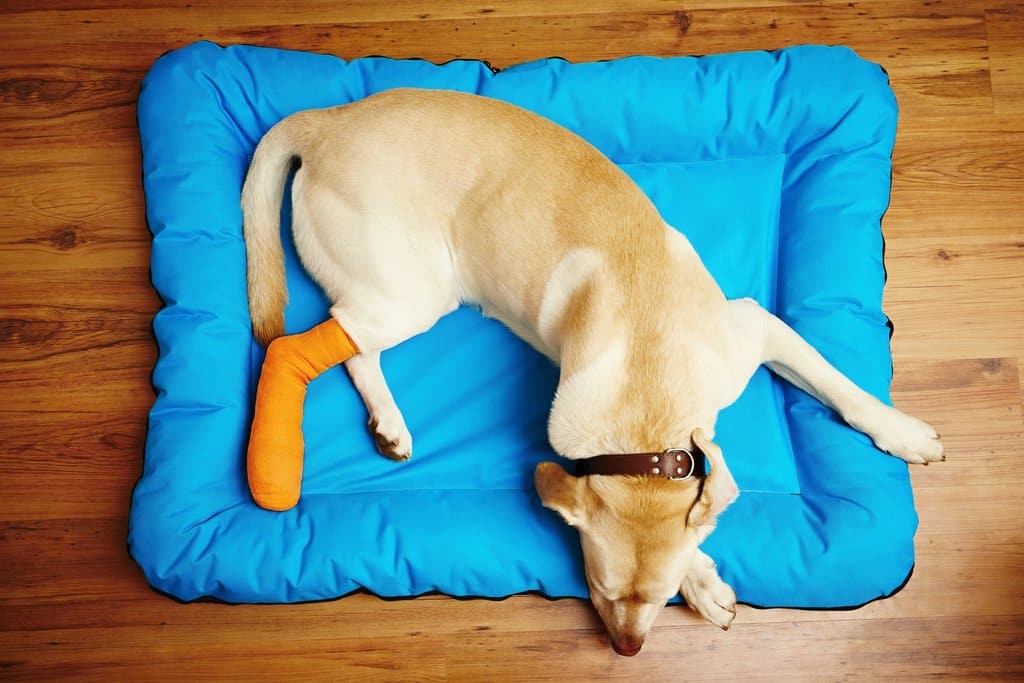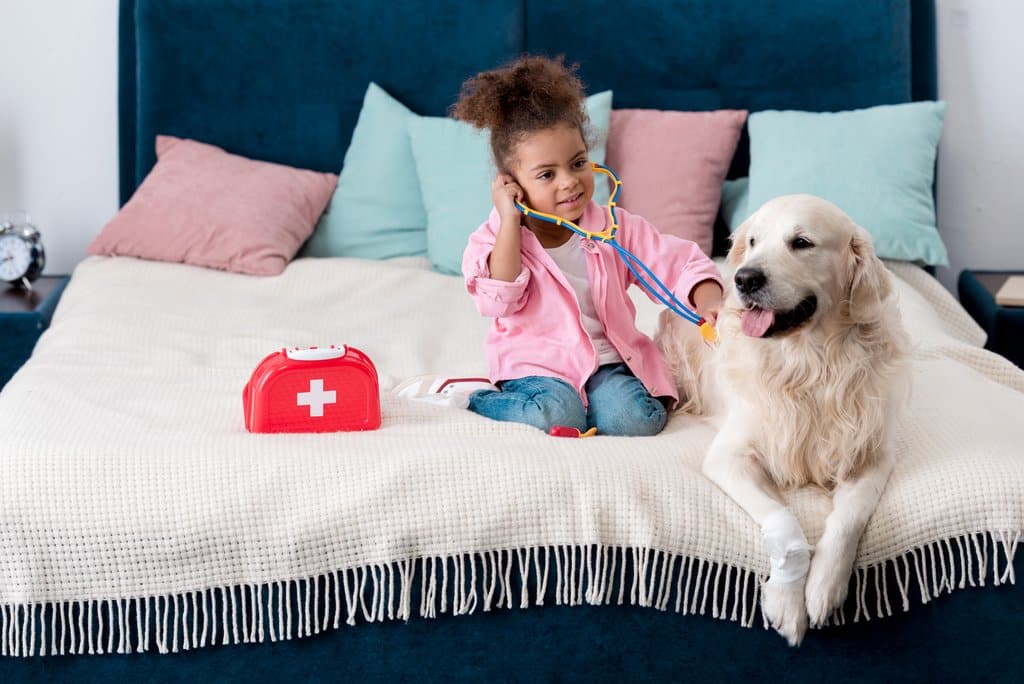Dogs Get Sick And Hurt Just Like Humans Do.
Learn these basic dog first aid tips to keep your furry friends safe.
You (hopefully) already know that having a pet is a big responsibility.
Like a child, pets are dependent on their caretakers for everything from food and water to love and companionship. But unlike children, your pet can’t speak up to tell you when something is wrong.
Sometimes, keeping your pup healthy, happy, and safe means knowing what to do in an emergency. This dog first aid guide will give you some tips on what to have on-hand and what to do.
Disclaimer: Emergency treatment and first aid for pets should never be used as a substitute for veterinary care. In an emergency, proceed with caution and take your pet to their veterinarian as soon as possible. If your dog has a chronic medical condition, discuss any first aid and life-saving procedures with your veterinarian.
First Aid First
First aid is one of the first things to learn once you become a puppy parent.
No one ever knows when their dog will get hurt or sick and—because there are no ambulances for dogs—giving them swift first aid could spell the difference between a close call and a full-blown disaster.
It’s important to reiterate that, while extremely important, first aid is never meant to replace emergency veterinary care.
The purpose of dog first aid is to:
- Keep them alive
- Reduce pain and symptoms of discomfort
- Minimize long-term effects of the illness or injury
No matter the emergency, you should always contact your vet so they can assess your dog’s condition and give you the best advice for them. However, there may be times when you have to act quickly—too quickly to stop and dial the animal hospital.
In these situations, it pays to be prepared with both the resources and the know-how to keep your pet safe.
Dog First Aid Kit
Having a few essentials on-hand (and in one place) can save valuable time when your dog needs it.
Here are a few things to include in your dog first aid kit:
- Gauze/non-adhesive bandages to dress wounds and stabilize joints (opt for latex-free, waterproof, and/or non-sticking materials)
- Cotton balls/swabs to apply ointments and clean wounds
- Hydrogen peroxide to induce vomiting—talk to your vet first!—and remove skunk smell (do not use on wounds)
- Antibiotic spray/ointment for smaller cuts and wounds
- Ice pack to reduce swelling
- Scissors (with blunt end) for removing bandages
- Beard trimmer for removing long fur without cutting their skin
- Saline solution for flushing out eyes and cleaning wounds
- Tweezers to remove splinters or ticks
- Old credit card to remove bee and wasp stingers (don’t use tweezers, as this can squeeze the venom sac and make things worse)
- Disposable gloves to reduce bacteria transmission
- Magnifying glass and flashlight
- Syringes to administer oral medication
- Blanket and towel to keep them calm, warm, and still
- Muzzle to prevent them from biting (never put a muzzle on a dog who is choking or vomiting!)
- Slip leash for quick, safe transport
- Styptic or clotting powder (such as ClotIt) to stop bleeding
- Dog first aid manual to provide lifesaving information at your fingertips
It’s also a good idea to include vet info, your pet’s medical records, and list of nearby pet shelters (this last one will come in handy during hurricane season).
If your vet has recommended over-the-counter medications for your dog in the past, you should also keep a few doses in your first aid kit for any future needs.
Keeping Your Pet Calm
In an emergency, your dog will be feeling panic, fear, and probably pain. And as any pet owner can tell you, a scared animal is a dangerous animal.
Even the best behaved dog may react without thinking if they are scared and in pain, and it is important that they remain calm so you and the vet can properly care for them. And the best way to keep them calm is to remain calm yourself.
Keep your voice low and slow, and speak soothingly to your dog. Use some soft blankets and/or towels to keep them warm (unless they have heatstroke) and do your best to keep them still.
Staying calm communicates to your dog that you have the situation under control and also enables you to think more clearly.
Common Dog Injuries
One of our favorite things about dogs—other than their endless capacity for love—is that each one has a different personality. Yet, despite their differences, there are some injuries and emergencies that are fairly common among dogs.
With any dog-related emergency, your first step should be to have someone call the veterinarian, but these dog first aid tips will tell you what to look out for and what to do in the meantime.
1. Foreign Ingestion
Whether it’s a chocolate bunny or your favorite shoes, dogs are famous for their “unique” appetites. But sometimes this trait can get them into trouble.
If your dog is choking, never try to grab the object, as you may get bitten or push it further in. Instead, thump them between the shoulder blades or give a few compressions to their rib cage.
If they swallowed something they shouldn’t have, call the vet and watch them carefully for signs of poisoning or bowel obstruction, such as vomiting, lethargy, and loss of appetite.
2. Car Collision
First, assess your dog for broken bones. If you suspect a fracture, keep the bone still while you transport them to the vet. Don’t attempt to set the bone yourself, as this can do more harm than good.
Even if their limbs seem to be intact, take them to the vet as soon as possible to check for internal bleeding and organ damage.

Yellow labrador retriever is sleeping with broken leg
3. Animal Bites/Scratches
If your dog is bleeding from a cut, scratch, or other wound, cover it with a clean gauze or bandage and apply pressure as needed to stop the bleeding. Avoid the temptation to keep checking that the blood has stopped. Peeking under the bandage once every three minutes is fine.
If your vet directs you to do so, you can try to clean the area with a saline solution.
4. Bleeding Nail
It happens to every pet parent eventually: you try to be careful while trimming their nails, but you end up cutting one just a little too short.
Cutting the quick can cause a surprising amount of blood and your dog will likely be skittish afterward. Stop the bleeding with a little styptic powder, cornstarch, or flour to get the blood to coagulate.
5. Heatstroke
Here in Florida, keeping your pet cool can be a yearlong battle.
To prevent heatstroke, never leave your pet in the car on warm days. The temperatures inside of a car can rise quickly, even in relatively “cool” weather and your dog cannot open the windows or doors to cool off. Heatstroke can even occur after a long walk in the heat of the day.
If your dog is panting, drooling, hot to the touch, and lethargic, reduce your dog’s core body temperature as quickly as possible.
Move out of direct sunlight (indoors or a shady area is best) and give them sips of cool water. Place cool (not cold), wet towels around your dog; wring out and rewet the towels as needed. Alternatively, you can gently run water over them with a hose, sweeping the water away as their body heat warms it up.
Conclusion
You want your pet to be around for a long time, which is why it’s important to know basic dog first aid in the event of an emergency.
But giving them a long, healthy life is also dependent on their daily lifestyle.
At Rick’s Dog Deli, your dog’s wellness is our top priority. That’s why we formulate our meals with only 100% USDA-inspected ingredients that have been combined to give your dog optimal nutrition. No matter what stage of life your dog is in, we have a meal s/he is sure to love!


